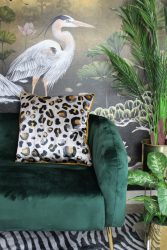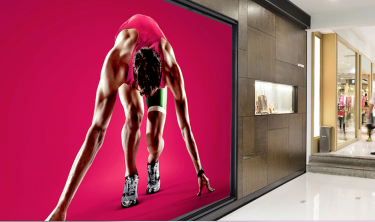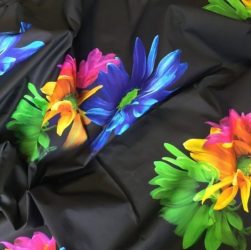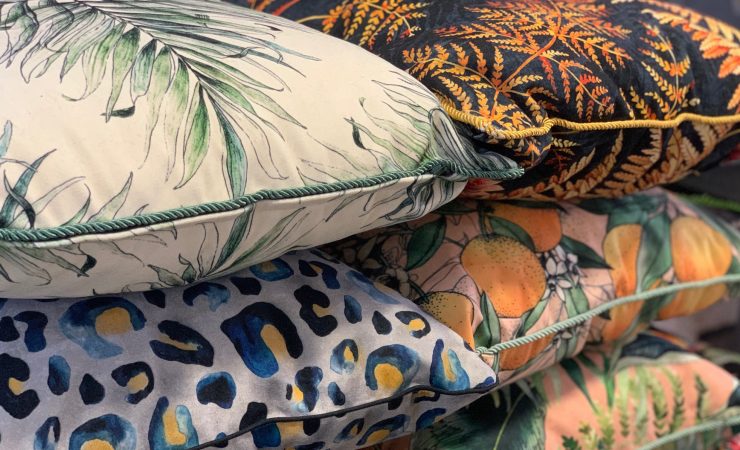As more and more digital printers investigate the wonderful world of textiles, it seems appropriate to provide an introduction to digitally printable textiles and the market trends affecting them. Digital Textile Printer spoke to several major suppliers to find out what you need to know
There are several quite distinct applications that all fall under the banner of textiles printing. From soft signage to interior décor, sportswear to fashion, flags to backlit displays, there is no end of viable areas for commercial printers to explore. However all of the areas require some specialist knowledge when it comes to the material you’re actually printing onto.
CMYUK
CMYUK offers digital-ready fabrics that are compatible with ink technologies including solvent, UV, sublimation/pigment inks and HP Latex. The company expects the printed textiles market to keep growing with Brett Platt, textiles business manager, saying, ‘The growth in textile printing for exhibition and retail has been huge in recent years, due to the fact that textiles are easier to handle, lighter in weight, and far more sustainable than traditional materials such as foam boards, plastics and PVC banner material.
‘We are also witnessing the growth of digital print in non-traditional markets such as interiors, décor and apparel. This is due to advancements in inks and fabrics, and on-demand printing which by its very nature allows for personalisation, eliminates waste and allows for faster to market design choices. Print service providers already have the technology and skills needed to service these emerging new markets and to provide new solutions in retail, expos, office interiors, furniture, interiors, apparel and more.’
Of course different applications require different substrates, as Mr Platt explains, ‘The end application determines what print technology, inkset and fabric should be used. When giving help and advice, CMYUK always starts with the application, and then works backwards, taking into account factors such as fire retardancy, washing frequency, usage – indoor or out, high or low traffic areas, and expected life span.

CMYUK say printers already have the technology and skills to service emerging markets
‘CMYUK offers a plethora of polyester fabrics for printing with paper sublimation or direct-to-textile. For longevity, washfastness and rubfastness, sublimated print should be fixed with a heat press. Natural fabrics printed with Textile Pigment Inks need heat fixation, as does the DuraVibe range of natural fabrics developed specifically for use with HP Latex inks. When printing with Solvent or UV inks, CMYUK textiles are top-coated and can be printed direct to fabrics for exhibitions, retail, tension frame systems (TFS), single piece wall coverings, backlit and front-lit displays.’
Premier
Another big player in this area is Premier Digital Textiles. The firm’s parent company, Premier Textiles, was founded in Manchester in 1981 but has grown to the point where Premier Digital Textiles now describes itself as Europe’s leading supplier of digital print ready fabrics. Director Nick Smith explains that the company currently offers ‘fabrics from stock that are uncoated, pigment coated, latex coated and reactive coated, so we cover the majority of digital print markets.
‘We supply customers globally, reaching a myriad of industries who incorporate our textiles in incredibly diverse ways. Our ongoing growth and success has allowed us to become one of the largest suppliers in our industry. Our best sellers tend to be stable woven fabrics that run well and sit flat on the printers, fabrics with stretch or movement tend to cause problems to new printers. However our stock ranges from light-weight fabrics for fashion and drapes to heavier options that tend to be used in more durable applications such as upholstery.’
Like CMYUK, Premier has seen growth in the textile printing sector and expects this expansion to continue. Mr Smith continues, ‘We have been involved with supplying inkjet ready fabrics for over 20 years. In the early days we supplied textile print studios with small rolls of fabric for sampling prior to bulk conventional print, we have seen printers evolve inks develop and volume increases. Twenty years on we are now a global business shipping to over 80 countries and are more than happy to supply single roll customers up-to volume multiple high-speed print customers.’

The race is on to take advantage of the opportunities available in textiles
Soyang
Offering ‘backlit materials, stretch materials, textiles made from recycled polyester, flag materials, mesh textiles and much more,’ is Lancashire-based Soyang Europe, a leading manufacturer and distributor of digitally printable media and surface coverings for the signage, design, marketing, construction and decor sectors.
When asked whether the different materials require different inks, treatments and finishing, the company’s Ella Faulkner explained, ‘You are able to print onto textiles using any of the following methods; eco solvent, solvent, UV, Latex, dye sublimation and direct transfer sublimation. This is dependent on the printer the customer has and the specific requirements of the material in question, as a company we are able to offer technical advice around the best ways to print certain materials if the customer hasn’t worked with a particular textile before.’
In terms of whether he would recommend specific textiles for customers new to the sector, Ms Faulkner says, ‘We have a few options for new customers entering the world of textiles that are extremely stable in terms of stretch or shrinkage. For those with a bit more experience we offer textiles with a lycra content for more exactin g applications and high-quality backlit textiles for stunning colour results.’
In terms of specific applications, he adds, ‘We have certain fabrics that are more suited to display and retail and others which would be better suited to exhibitions for example. We would be able to advise which the best textile would be for the customer’s specific needs.’
2020
Naturally the completely unprecedented events of 2020 have impacted just about every industry, with commercial print hit hard. In terms of the textile printing sector, growth didn’t precede as fast as predicted prior to the pandemic, but in such a bizarre world, that pretty much qualifies as success.

Premier Digital Textiles covers ‘the majority of digital print markets.’
Supply chains were of course impacted by Covid, and Brexit has played a part as well, though none of the companies Digital Textile Printer spoke to expect the effects to be severe or long term. CMYUK’s Mr Platt commented, ‘We have a constant supply, pride ourselves partnering with the most sustainable and forward-thinking manufacturers in the world today. While transportation costs have increased due to the pandemic and the teething problems of Brexit, we see that this will settle down in the not-too-distant future.’
Premier’s Mr Smith added, ‘Without a doubt, our supply chain is complex with many stages of manufacture. During the past year we have faced many supply challenges as well as demand spikes, managing stocks is difficult at the best of times but during these unpredictable times many suppliers have had periods closed, freight availability has been reduced, goods are being held up in customs, so meeting customers’ needs has been challenging. Fortunately our customers have been really understanding and we have and continue to be well stocked.’
Speaking specifically about Brexit he adds, ‘Over the last few months we have had great difficulty finding reliable freight forwarding options, and experienced many delays in getting goods to our EU customers. The problems seem to be slowly reducing, but we have had customers cancel orders due to excessive delays.’
Growth areas
In terms of specific growth areas that textile printers should be keeping an eye on each of our suppliers had quite a lot to say. Soyang’s Ms Faulkner predicts, ‘We believe that eco-friendly materials are becoming more and more popular as the world becomes more conscious of climate change. While polyester is fully recyclable, we are able to offer textiles made from recycled polyester which is therefore much kinder to our environment. As a company, we are able to create and produce textiles which are much more environmentally friendly and this is where we are able to stand out from the rest.’
Premier’s Mr Smith largely agreed, adding, ‘Interest in our eco/sustainable range of fabrics has significantly increased recently and we have taken the opportunity to develop more innovative solutions during Lockdown, we have developed more home decor fabrics that have been certified for the HP platforms and we will continue to add to our class leading range of fabrics during this year culminating with new swatch books in polyester, natural and eco base-cloths.

Soyang, based in Accrington, but serving international markets
‘There has definitely been increased demand, especially over the last 12-18 months, from customers for more sustainable products and the textile sector is constantly evolving to become greener. We have gone from having a handful of sustainable products to now offering an entire range. In terms of what the textile sector needs to do to become ‘greener’ it needs to now look at the end life of textile products and how the sector can become a circular model rather than linear.’
It was Mr Platt from CMYUK who, whilst stressing that sustainability is definitely a priority, says that there are lots of potential growth areas to get excited about. Speaking about the former topic he explained, ‘The nature of digital printing is to output on demand, so no long runs of wasted textile. With regards to the make-up of the textile materials, organic, recycled and natural yarns are increasing in usage across the sectors. Printed graphics, for example, really benefit from textiles – they can be folded for example, making them easier to transport, store and handle. Eco responsible materials, once just an add-on have now arrived – squaring the circle of sustainability, high-performance and price.
‘Across the board we see a drive towards earth-responsible materials, and a vast reduction in PVC items, solvents and chemicals. CMYUK is the leader in eco textiles with materials such as UFabrik, which is made from the yarn of recycled PET plastic waste, and PVC-free Kavalan. And of course, all our digitally prepared polyesters are recyclable. Through our in-house expertise and knowledge, we are able to guide new and existing customers to diversify or enter these new market areas.’
Expanding onto other issues he concludes, ‘Fabric technology is improving all the time. Digitally prepared polyesters can be used for many applications from display, signage, and more recently have evolved for use in interiors, sportswear and fashion.
‘Our newly launched polyesters have multiple weaves and handles, drape beautifully, and are soft to the touch. They imitate natural fabrics very convincingly – linens, cottons, silks, wool, tweeds – all perfect for the burgeoning digital décor and fashion markets. All polyesters can be printed with paper sublimation, and some if coated, can be printed direct using UV inks, mainly for display and signage applications.
‘Another growing sector is digitally printing natural materials, and textile pigment inks lead the field. This is because advancements in pigment ink technology can now provide a colour gamut that was simply unachievable in the past.
‘Historically, to get a good colour on natural cottons and linens meant you needed to use reactive inks. However, these need lengthy finishing processes including steaming and washing, both time consuming and expensive. Pigment printing on the other hand, doesn’t require either, just heat fixing. This has made printing onto natural cottons and linens much easier and less expensive, allowing customers old and new clear access to these high-yield and fast-growing markets.’





